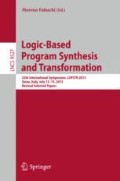Abstract
We propose a polynomial static analysis for Brane Calculi [6], based on Abstract Interpretation [8] techniques. The analysis provides a description of the possible hierarchical structure of membranes and of the processes possibly associated to each membrane, together with global occurrence counting information. Our analysis can be applied in the biological setting to investigate systems in which the information on the number of membranes occurring in the system plays a crucial role.
Access this chapter
Tax calculation will be finalised at checkout
Purchases are for personal use only
Notes
- 1.
For brevity, from now on, we will usually write membrane \(\varGamma \), instead of membrane labelled by \(\varGamma \).
- 2.
Here, \(X \subseteq {\mathtt{Sys}}\) stands for the set of systems that are reachable from system P.
- 3.
We also assume the system S to be well labelled.
- 4.
For simplicity, we omit the explicit indication of the parameter d (assume fixed once for all).
- 5.
For simplicity, we use \({t^{\circ }} \) for both abstract systems and processes.
- 6.
For simplicity, we omit the explicit indication of the parameter d when is clear from the context.
- 7.
where \( lfp \) is the least fixed point.
- 8.
Note that giving the two membrane sources the same label does not influence the result.
References
Bodei, C.: Control flow analysis for beta-binders with and without static compartments. Theor. Comput. Sci. 410(33–34), 3110–3127 (2009)
Bodei, C., Brodo., L.: Brane calculi systems: A static preview of their possible behaviour. CoRR abs/1108.3429 (2011)
Bodei, C., Gori, R., Levi, F.: An analysis for causal properties of membrane interactions. Electr. Notes Theor. Comput. Sci. 299, 15–31 (2013)
Bodei, C., Gori, R., Levi, F.: Causal static analysis for brane calculi. Theor. Comput. Sci. 587, 73–103 (2015)
Busi, N., Zandron, C.: Modeling and analysis of biological processes by mem(brane) calculi and systems. In: Proceedings of the Winter Simulation Conference WSC 2006, pp. 1646–1655. WSC (2006)
Cardelli, L.: Brane calculi. In: Danos, V., Schachter, V. (eds.) CMSB 2004. LNCS (LNBI), vol. 3082, pp. 257–278. Springer, Heidelberg (2005)
Cardelli, L., Gordon, A.: Mobile ambients. Theor. Comput. Sci. 240(1), 177–213 (2000)
Cousot, P., Cousot, R.: Static determination of dynamic properties of generalized type unions. In: Language Design for Reliable Software, pp. 77–94 (1977)
Feret, J.: Confidentiality analysis of mobile systems. In: Palsberg, J. (ed.) Static Analysis. LNCS, vol. 1824, pp. 135–154. Springer, Heidelberg (2000)
Feret, J.: Abstract interpretation-based static analysis of mobile ambients. In: Cousot, P. (ed.) SAS 2001. LNCS, vol. 2126, p. 412. Springer, Heidelberg (2001)
Feret, J.: Occurrence counting analysis for the pi-calculus. Electr. Notes Theor. Comput. Sci. 39(2), 1–18 (2001)
Feret, J.: Abstract interpretation of mobile systems. J. Log. Algebr. Program. 63(1), 59–130 (2005)
Feret, J.: Analysis of mobile systems by abstract interpretation. Ph.D. thesis, Ècole Polytechnique, Paris, France (2005)
Gori, R., Levi, F.: An analysis for proving temporal properties of biological systems. In: Kobayashi, N. (ed.) APLAS 2006. LNCS, vol. 4279, pp. 234–252. Springer, Heidelberg (2006)
Gori, R., Levi, F.: A new occurrence counting analysis for bioambients. In: Yi, K. (ed.) APLAS 2005. LNCS, vol. 3780, pp. 381–400. Springer, Heidelberg (2005)
Gori, R., Levi, F.: Abstract interpretation based verification of temporal properties for bioambients. Inf. Comput. 208(8), 869–921 (2010)
Guerriero, M., Prandi, D., Priami, C., Quaglia, P.: Process calculi abstractions for biology. In: Condon, A., Harel, D., Kok, J.N., Salomaa, A., Winfree, E. (eds.) Algorithmic Bioprocesses Natural Computing Series, pp. 463–486. Springer, Heidelberg (2009)
Levi, F., Maffeis, S.: On abstract interpretation of mobile ambients. Inf. Comput. 188(2), 179–240 (2004)
Milner, R.: Communicating and mobile systems: the \(\pi \)-calculus. Cambridge University Press, Cambridge (1999)
Nielson, F., Hansen, R., Nielson, H.R.: Abstract interpretation of mobile ambients. Sci. Comput. Program. 47(2–3), 145–175 (2003)
Nielson, F., Nielson, H.R., Priami, C., da Rosa, D.S.: Control flow analysis for bioambients. ENTCS 180(3), 65–79 (2007)
Nielson, H.R., Nielson, F.: Shape analysis for mobile ambients. In: Proceedings of the 27th ACM SIGPLAN-SIGACT Symposium on Principles of Programming Languages (POPL 2000), pp. 142–154. ACM Press (2000)
Nielson, H.R., Nielson, F., Pilegaard, H.: Spatial analysis of bioambients. In: Giacobazzi, R. (ed.) SAS 2004. LNCS, vol. 3148, pp. 69–83. Springer, Heidelberg (2004)
Pilegaard, H., Nielson, H.R., Nielson, F.: Context dependent analysis of bioambients. In: Simulation and Verification of Dynamic Systems. Dagstuhl Seminar Proceedings, vol. 06161 (2006)
Pilegaard, H., Nielson, H.R., Nielson, F.: Pathway analysis for bioambients. J. Log. Algebr. Program. 77(1–2), 92–130 (2008)
Priami, C., Quaglia, P.: Beta binders for biological interactions. In: Danos, V., Schachter, V. (eds.) CMSB 2004. LNCS (LNBI), vol. 3082, pp. 20–33. Springer, Heidelberg (2005)
Regev, A., Panina, E., Silverman, W., Cardelli, L., Shapiro, E.: Bioambients: An abstraction for biological compartements. Theor. Comput. Sci. 325(1), 141–167 (2004)
Vitale, A., Mauri, G.: Communication via mobile vesicles in brane calculi. ENTCS 171(2), 187–196 (2007)
Author information
Authors and Affiliations
Corresponding author
Editor information
Editors and Affiliations
Rights and permissions
Copyright information
© 2015 Springer International Publishing Switzerland
About this paper
Cite this paper
Bodei, C., Brodo, L., Gori, R., Hermith, D., Levi, F. (2015). A Global Occurrence Counting Analysis for Brane Calculi. In: Falaschi, M. (eds) Logic-Based Program Synthesis and Transformation. LOPSTR 2015. Lecture Notes in Computer Science(), vol 9527. Springer, Cham. https://doi.org/10.1007/978-3-319-27436-2_11
Download citation
DOI: https://doi.org/10.1007/978-3-319-27436-2_11
Published:
Publisher Name: Springer, Cham
Print ISBN: 978-3-319-27435-5
Online ISBN: 978-3-319-27436-2
eBook Packages: Computer ScienceComputer Science (R0)

